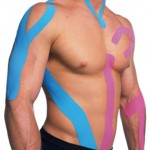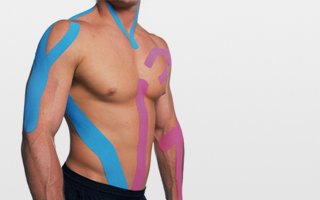
Kinesio taping has been around since the 1970s and was created by a Japanese chiropractor, Dr. Kenzo Kase. Kinesio tape has since taken the world of sports rehabilitation by storm and gained increased notoriety since the Beijing Olympics in 2008. It was first introduced to Australia in 2004 and we can now see it on most athletes that have an injury and are still competing i.e. professional tennis players, NRL players, netballers, basketballers, swimmers and the list goes on…
Kinesio tape is made of 100% cotton and has elastic properties that are similar to the skin. It is latex-free and has an acrylic heat-activated backing that can stretch only along its longitudinal axis. Therefore skin irritation is minimal and allergic responses that we can see from rigid tape are not present. If an allergic reaction occurs, this is normally due to the application of the tape and not due to the tape itself. The benefit of the low skin irritation means the tape can be worn by anyone from children to the elderly and can be left on for up to 3-5 days. The tape can be worn in the shower/bath or can even be worn by swimmers in the pool and provide the support needed.
The tape comes in different colours and has a variety of uses that range from support and stability to increasing the lymphatic drainage and swelling in an area, such as in lymphedema of a limb or an acute injury such as an inversion sprain (rolled ankle). It has also been shown to help in reducing the formation of scar tissue after surgery and preventing keloid scar formation. Kinesio tape can help to facilitate or inhibit/relax a muscle, which this can be beneficial in patella femoral tracking syndrome where the iliotibial band (ITB) and lateral quadriceps are normally tight and the vastus medialis obliquus (VMO) is weak.
Kinesio tape helps provide support to an injury but also allows full range of motion, which rigid tape doesn’t allow. Not allowing full range of motion reduces the amount of proprioception from the joint mechanoreceptors and therefore in the long term weakens the joint and predisposes it to further injury. Kinesio tape differs in that it provides the support needed to protect the injury, but allows the full range of motion. This full range of movement stimulates the flow of lymphatic tissue and the mechanoreceptors to help provide a neurological stimulation and rearrange the underlying fascia. Hence, the neural pathways and connective tissue can then be retrained in the correct position, improving the biomechanics and helping to rehabilitate the injured site and prevent further re-injuries.
If you would like more information or would like to book an appointment at Neurohealth – please call the clinic on 9905 9099 or email us admin@neurohealthchiro.com.au or fill in the contact form from our website www.neurohealthchiro.com.au
Sign up to receive Neurohealth Chiropractic’s Free monthly health newsletter on the Right Hand Side of this page. Filled with great information and lots of easy health tips to keep you at Optimal Health!
This article is written by Dr. Steven Cannon, Chiropractor @ Neurohealth
- Kase, K., Wallis, J., and Kase, T. (2003) Clinical Theraputic applications of the Kinesio Taping Method®. Ken Ikai Co. Ltd, Tokyo, Japan
- Rock Stockheimer, K., Kase, K., and Pillar, N. (2006) Lymphoedema and Chronic Swelling. Kinesio USA, LLC.
- Yasukawa, A., Martin, P., and Kase, K. (2006) Kinesio Taping in Pediatrics. Kinesio USA, LLC.
- Nosaka, K. (1999). The Effect of Kinesio Taping® on Muscular Micro-Damage Following Eccentric Exercises. 15th Annual Kinesio Taping International Symposium Review. (pp. 70-73) Tokyo, Japan: Kinesio Taping Association.




